Introduction
Aluminum profiles play a critical role in various industries, from construction to transportation. Their lightweight, durable, and versatile nature makes them indispensable. However, handling aluminum profiles, especially during the stretching process, requires meticulous care to maintain their integrity and performance. In this article, we’ll explore the essential precautions to take when stretching aluminum profiles to ensure quality and safety.
Cooling Before Stretching
One of the most crucial steps before stretching aluminum profiles is to cool them below 50 degrees Celsius. Stretching at higher temperatures can lead to severe consequences, including burns to workers and damage to the wool strips used in the process. Moreover, high temperatures prevent the complete elimination of internal stresses within the aluminum, leading to issues like bending, twisting, and other deformations both before and after the aging process.
Controlled Stretching Amount
To achieve optimal results, the stretching amount should be controlled at around 1%. Overstretching can result in dimensional errors at different points of the profile, surface defects resembling fish scales, reduced elongation, increased brittleness, and overall poor plasticity. On the other hand, insufficient stretching can lead to low compressive strength and hardness, which even the aging process cannot remedy, often causing the profile to bend into an arc shape.
Use of Appropriate Clamps and Methods
Utilizing the correct special clamps and methods is essential for managing stretching deformation and controlling dimensional changes effectively. Different profiles, such as open, arc, cantilever, and curved profiles, require specific attention and techniques. Proper clamps help ensure that the stretching force is distributed evenly, reducing the risk of defects and maintaining the profile’s intended shape and dimensions.
Attention to Stress Conditions
Particular attention must be paid to profiles with high width-to-thickness ratios, long overhangs, large curvatures, and significant wall thickness differences. These profiles are prone to partial or point-shaped deformations, twisting, and spiral defects. By carefully monitoring and managing the stress conditions, these defects can be minimized, ensuring the profiles meet the required specifications.
Uniform Heat Dissipation
Wool strips used in the stretching process provide necessary heat insulation. However, for aluminum profiles with high decorative surface requirements, it is vital to frequently turn them up and down and back and forth. This practice ensures uniform heat dissipation, reducing the likelihood of horizontal bright spot defects caused by uneven heat distribution and varying crystallinity.
Handling and Moving Aluminum Profiles
During the processes of picking, moving, and stretching, aluminum profiles should not rub, pull, stack, crowd, or entangle with each other. Maintaining a certain distance between profiles is crucial. Profiles that are easy to bend or have short discharge lengths require timely handling and maintenance treatments to prevent damage.
Conclusion
Proper handling and stretching of aluminum profiles are vital to maintaining their quality and performance. By adhering to these precautions—cooling profiles adequately, controlling stretching amounts, using appropriate clamps, paying attention to stress conditions, ensuring uniform heat dissipation, and careful handling—industries can avoid defects and ensure the longevity and reliability of their aluminum products.

